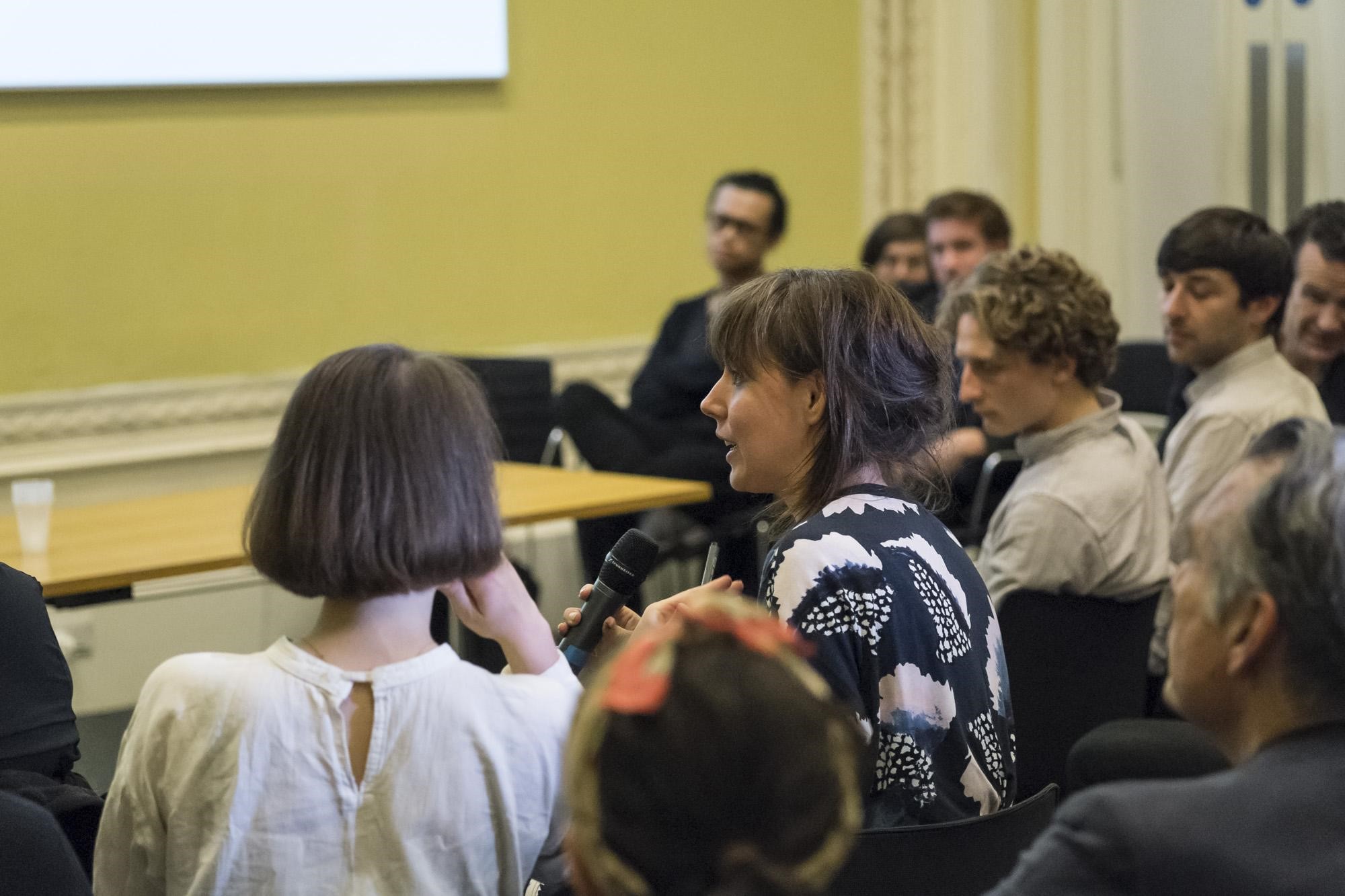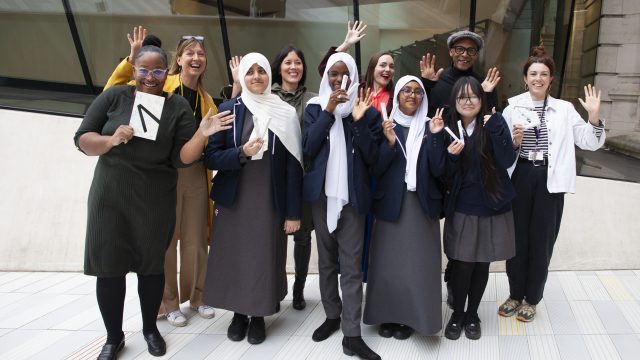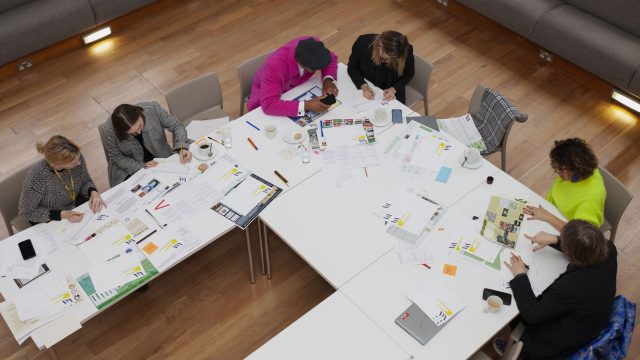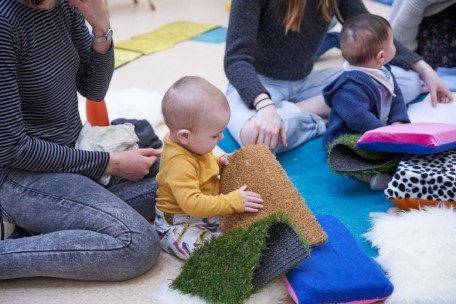‘Entangled: Art, Science and Quantum Computing’ is a two part post by our guest blogger, Dr. Libby Heaney. The Digital Programmes Learning Team and the Digital Art section of the Word & Image department have been delighted to work with her and the System Research Group.
Quantum Computer Artworks
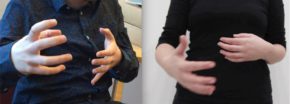
Georgia Ward Dyer copies the gestures the scientists made when describing the science behind quantum computing. © Georgia Ward Dyer
The Map is Not the Territory
Georgia Ward Dyer’s piece The Map is Not the Territory, highlights the lack of accessible language around quantum computers and their underlying science. After secretly filming her scientist collaborators, Georgia re-performed the hand gestures they used to communicate the ‘borderline impossible’ concepts of quantum computing. The Map is Not the Territory acts to remind us of the challenges of representation and Georgia describes it as a critique of art/science collaborations. The work is universal – The Map is Not the Territory could be viewed as a response to any missing object – and we have all experienced situations of miscommunication and slippages.
The paradox that quantum mechanics invariably presents to the intuition is that the physical reality proposed by the theory is both unpicturable and picturable. The actual object in question is inconceivable, because it is only visualized by conceptualizing the unresolvable tension between what can and cannot be pictured – James Elkins 2008
In Six Stories from the End of Representation, art critic James Elkins writes that it is impossible for language or indeed representation as a whole to communicate the concepts of quantum science (and this extends to quantum computing). This is because a measurement on a quantum system destroys the system, so in general it cannot be copied, captured or viewed. Therefore when engaging with quantum physics artistically, is it important to move beyond a critique of representation rather than becoming ensnared by it? With quantum computing, should the ultimate failure of representation be clear at the outset?
Art should be critical and also provide new ways of thinking, being and speculating. In the 1960s artist Robert Rauschenberg and Billy Kluever joined together to form Experiments in Art and Technology (EAT), which they supposed through collaboration could ‘direct and control forces of cultural change in an ethical and just way’ [1]. And, like Rauschenberg and Kluever, I too believe it is crucial to engage with new technology rather than to sit back, criticize and let the technologists, corporations and politicians (etc.) decide the agenda.
Other artworks produced by the collaboration resulted from direct interaction with quantum technologies or quantum simulations. By creating direct experiences and using digitally mediated interactions, the works begin to circle the void left by inadequate representations, thereby embracing a degree of complexity and the unknown.
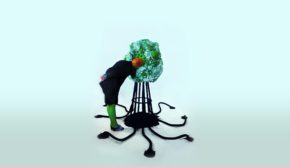
The Alien Present © Rose Leahy, Amanda Baum and Rob Walker
The Alien Present and Measured Matter
The Alien Present by students Rob Walker, Rose Leahy and Amanda Baum in collaboration with Jeremy Adcock and Sam Morley-Short; and Measured Matter by Marcela Uribe Fores, Louis Schreyer, Taeyoung Choi and Thibaut Evrard used data from quantum simulations and experiments to create experiences that entangle the audience members with the artworks and bring quantum thinking to other fields. By doing so, they no longer attempt to represent quantum phenomenon but instead take a performative approach where the audience gain intuition of quantum computing’s conflation with other areas through digitally-mediated interaction.
The Alien Present is a sculpture where a screen inside the piece shows structured or deconstructed images of gardens contingent on whether a camera recognises an individual’s face or not. The presented images become fluid when the viewer looks away and fixed when the viewer is looks directly at them. The work therefore explores the tension between looking and un-looking, which might be interpreted as the active or performative version of Elkin’s tension between the picturable and unpicturable.

Daniel Brown’s digital artwork On Growth and Form © V&A Museum, London/ Daniel Brown.
The tension between the gaze and un-gaze can be contrasted with Daniel Brown’s aforementioned piece which uses software to continuously animate the flowers such that they are ever changing and continuously growing. Brown’s work has a linear relationship with the viewer, the continuous fluid motion of the work often mesmerises the audience, fixing the persons gaze for a certain amount of time, rather than blurring boundaries between the known and unknown.
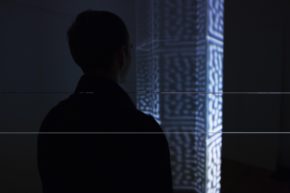
Measured Matter by Marcela Uribe Fores, Taeyoung Choi, Louis Schreyer and Thibaut Evrard
Measured Matter
Measured Matter is a hybrid physical-digital installation, where patterns of light are projection mapped onto a transparent column following quantum data dependent on how the audience members walk around in the space. Rather than playing on the tension of looking and un-looking, here the group entangles the audience to the artwork by tracking their positions and movements in the space around the column. The non-linear interplay of movement of people and patterns lead to emergent behaviour entangling humans with the light on the column and proposing new forms of interacting with architectural spaces.
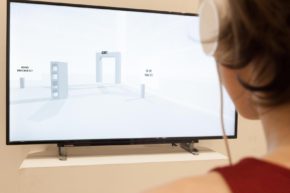
Original Simulation by Maria Euler and Ker Siang Yeo
Original Simulation
Taking a more direct approach to conveying information, Original Simulation by students Maria Euler and Ker Siang Yeo and scientists Sam Pallister and Henry Semenenko is an interactive video game-style simulation of a gallery space where key artworks related to ideas of the original and copy are quantum teleported onto their forgeries. Quantum teleportation destroys the original as the information is re-constructed in the new location. Through a soundtrack that explains details of the theory of teleportation, the work encourages people to re-think the notions of original and copy through the lens of quantum computing.
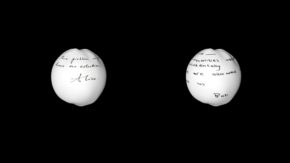
A projection of two ‘photons’ with text from love letters constructed by Anna Ridler and Daria Jelonek.
Alice and Bob
Students Anna Ridler and Daria Jelonek’s artwork, Alice and Bob, is a series of love letters constructed by the artists from words they have taken from quantum computing papers. Words endemic to quantum physics such as entanglement and collapse reminded the artists of romance novels. Alongside scientists Eric Johnston and Euan Allen, the artists followed the structure of logic gates in a four qubit quantum computer, and the various ways of generating the four bit outputs, as a system for arranging the order of the letters in a linear book across three acts, thereby bringing a human element to the science.
Nibbles – the documentation of an artwork made by a quantum computer
My work is called Nibbles—Documentation of an artwork made by a quantum computer and was produced following an intense period of research into the parallels between quantum physics and deconstruction theory. Physicist Niels Bohr noted that word and world are tied to each other, and I was interested in exploring this notion further. Nibbles is a conceptual artwork comprised of documentation made by deconstructing the notion of a ‘genuine’ quantum work of art. Some of this documentation attempts to simulate the experience of quantum entanglement applying a similar method to the logic gates used to entangle particles to images.
Genuine quantum artworks
The first step was to create a sequence of ‘genuine’ quantum artworks using a four-qubit quantum computer, in collaboration with scientists Sam Holder, Lawrence Rosenfeld and Jeremy Adcock. Each of these artwork is made from just four particles of infra-red light, exists for a tiny fraction of a second and is detect it requires equipment colder than deep outer space. These entangled structures also defy artistic categorization sitting in a void between sculpture, photography, digital art etc. Sketched representations of these graph states in the scientists’ notebooks look similar to Sol LeWitts’ Incomplete Open Cubes or Manfred Mohr’s artworks. However, these representations entirely fail to capture the actual art object and act merely as free approximations of the underlying reality. The actual art object lives in a 15-dimensional space, which is inconceivable and not dissimilar to the higher-dimensional space of Mohr’s Hypercubes.
The most direct and clearest snapshot of each artwork is just four bits of information—half a byte—otherwise known as a nibble.

Still from Nibbles – Documentation of a work of art made by a quantum computer questions whether it is possible to create the experience of quantum entanglement through meaning? © Libby Heaney
Documentation through experience
In the quantum computer, the entanglement that forms the artwork was created by deleting information allowing the particles of light to become indistinguishable. So I became interested in the idea of deleting information in images and whether indistinguishable images and videos and the resulting blurring of meaning could create an experience of quantum entanglement. I created a four-screen moving image work with a spoken narrative, poetically documenting the genuine quantum artworks. Perhaps the obvious inherent contradictions in judging whether these experiments are a success (!!), add to the meaning of this artwork, venturing into the territory between the known and unknown.
The images in this video as well as the words in the narrative are based upon data tracing the edges of representation or the quantum void: data from the laser; infra-red images of the space; videos of the chip; measured sizes, distances and times; data about materials and recorded sounds of equipment using contact microphones and electrical pickups. This cacophony of inadequate representations sit just outside the quantum world, but these and other indistinguishable instances were placed together in the video following a system in time and space with similar rules to the quantum computational algorithm that generated the genuine quantum artworks.
[1] Grant D. Taylor, When the machine made art, Bloomsbury 2014
